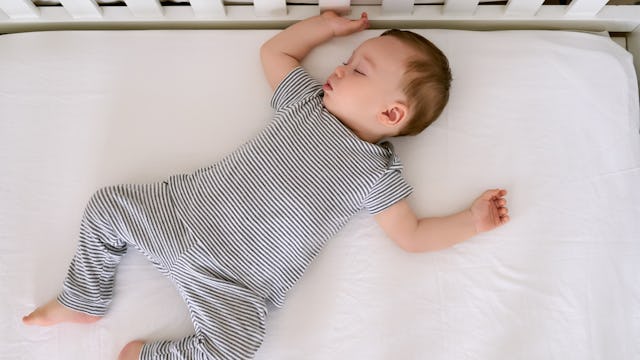Study Shows Relatives And Babysitters Are Failing At Sleep Safety

Friends and relatives need to be educated about SIDS before taking care of your baby
As a new parent, you’ve probably done mountains of reading when it comes to preventing Sudden Infant Death Syndrome (SIDS) and safe infant sleep practices. It’s information that’s covered everywhere from your pediatrician visits to new parent workshops to online mom groups. But what you might not realize is that safe sleep practices are relatively new, and that grandma and your kindly neighbor might not be as familiar with phrases like “back is best,” if they’ve even heard it at all.
An eye-opening new study conducted by the University of Virginia Health System and published in The Journal of Pediatrics has found that while parents and licensed childcare providers are quickly catching on when it comes to safe baby sleep practices that reduce SIDS, friends, relatives, and the babysitter from next door may not know the first thing about how to help prevent the most common cause of death for kids under a year old.
The study examined 10,000 cases of SIDS and then focused in on the 1,375 cases that involved a death while the parent wasn’t present. The results found that currently, mother (and father) know best when it comes to preventing these deaths, and that parents need to better educate their non-licensed caregivers.
Here are the standout facts:
- Relatives and friends were significantly more likely than parents to place the baby in hazardous sleep environments, including adult beds, couches, or areas with blankets, bumpers, or toys.
- Although above 70 percent of licensed caregivers put babies to sleep in a crib, only 49.1 percent of babysitters did. Only 29.4 percent of relatives and 27.1 percent of friends put babies to sleep in a crib.
- While 54.1 percent of childcare providers placed infants to sleep on their back, only 38.4 percent of relatives, 38.6 percent of friends and 37.8 percent of babysitters placed babies on their back to sleep.
While the above findings are shocking, the good news is that it’s an easy fix: parents need to be educating all caregivers about safe sleep practices, which include:
- Always put your baby to sleep on his or her back.
- Always put your baby to sleep in a crib or bassinet with a firm mattress.
- Remove all blankets and pillows from the crib.
- Remove any other objects that could be hazardous, including stuffed animals, toys, and bumpers.
- Do not place your baby to sleep on an adult bed or couch.
- Do not sleep in bed with your baby.
“It’s always best to discuss where and how your baby should sleep,” said lead researcher Rachel Moon, MD, of the University of Virginia School of Medicine, the UVA Children’s Hospital and UVA’s Child Health Research Center. “You can’t make assumptions that the person with whom your baby is staying will know what is safest.”
“A lot of relatives and friends may not be aware that babies are safest on their backs,” added researcher Jeffrey Colvin, MD, of Children’s Mercy Kansas City. “They may have raised children before we knew that this was safest.”
While new 2016 infant sleep guidelines from the American Academy of Pediatrics acknowledge that many families either purposefully or inadvertently co-sleep with their infants, and while they now share safe co-sleeping practices on their website, the group still recommends following as many of the safety guidelines as possible, whenever possible, which include: supine positioning, a firm blanket-free mattress, and a hazard-free environment. They also stress that couches and chairs are among the most dangerous sleep environments for babies, especially under four months of age.
It’s also important to note that medical experts believe that not all cases of SIDS can be prevented–a study published just last week found that a subset of children who have died of SIDS had a genetic mutation that affected their respiratory muscle function. But while it’s unclear exactly what causes SIDS, science has found that taking certain precautions absolutely lowers the chances of its occurrence. For that reason, be totally certain that all of your caregivers, from your mom to your after-school sitter, are as familiar with SIDS precautions as you are.
This article was originally published on